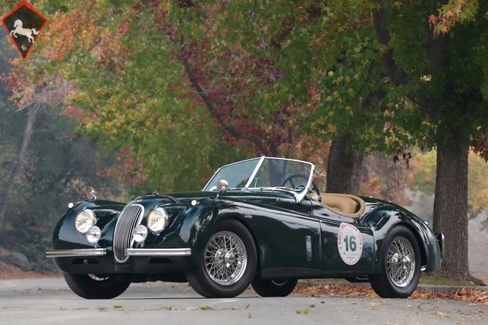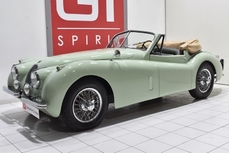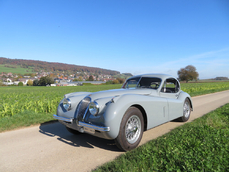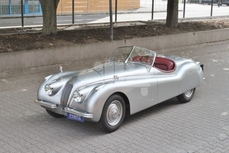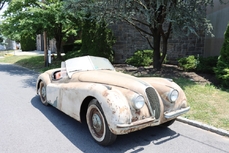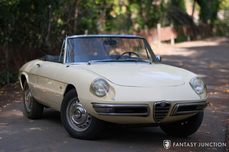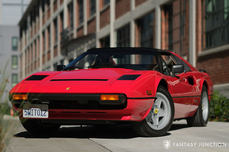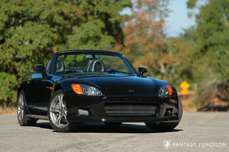Jaguar XK120 3.4 Liter DOHC Inline-6 no. F3735-8 1954
Allgemeine Beschreibung :
1954 Jaguar XK 120 Roadster
Chassis No. 676138, Engine No. F3735-8
British Racing Green with Tan Leather Interior
It is hard to imagine the enthusiasm that greeted Jaguar when, just three years after the end of World War II, they revealed the XK 120. With the wartime austerity still very fresh, the XK120 caused quite a stir. With its stunning styling, sophisticated mechanical specification, and unapologetically sporting ethose, the XK 120 was nothing short of a revelation. The elegant and avant-garde XK 120 not only boosted morale among the weary UK population, it demonstrated to the world that Britain had both the technical capacity and design excellence to deliver a sensual and emotionally engaging car.
Although originally intended to be a concept car showcasing Jaguar’s remarkable new twin-cam inline-6 cylinder engine designed for their large sedans, the breathtaking styling and genuine 120 mph performance of the XK120, coupled with an affordable price, captured the imagination of the world. In short order, the largely hand-built aluminum-bodied car was rushed into limited production as orders came flooding in. With time and delivery pressures growing, Jaguar immediately realized they needed to reengineer the car for mass production and developed tooling to produce thousands of cars with steel bodies to meet the significant demand. This effort not only improved output, it allowed Jaguar to expand their market share exporting to North America and other parts of the world.
The car’s heart was, of course, the fabulous XK engine. Conceived in wartime, the 3.4 litre “six” embodied the best of modern design, boasting twin overhead camshafts in an aluminum-alloy cylinder head, seven main bearings, all of which produced a maximum output of 160bhp. When installed in the lightweight XK120, the result was a car with a phenomenal power-to-weight ratio and blistering performance. The “120” referred to the car’s top speed, any doubts about these claims were swiftly banished when a standard XK120 achieved a top speed of 126.4 mph with hood and side screens erected and 132.6 mph at Jabbeke with a few drag-reducing modifications including bubble canopy and under tray. The XK120 set new standards of comfort, road holding and performance for British sports cars and, in keeping with the Jaguar tradition, there was nothing to touch it at the remarkably affordable price.
This particular XK120 is a restored matching numbers example, presented in classic colors. Believed to have originally been delivered new in Washington state, the car was sold in 2012 by Fantasy Junction to the current owner. At that time, the car was an event-proven structurally superb example with plenty of patina, finished in red with tan interior. It had frequently participated in many events including the California Mille in 2007, 2008, and 2010, as well as the Peak to Peak Rallye in 2009. The current owner has done a remarkable job restoring the car to a delightful aesthetic standard as well as upgrading the car for greater driving pleasure. After the restoration, he completed the California Mille once more in 2014.
A high quality repaint was performed by experts at R&M in Albany, California as well as a complete interior by Armand’s Auto Upholstery in Walnut Creek. Extensive mechanical and final sorting work were also performed by Steve Gordon of Vintage Auto Service in Oakland. Mechanical upgrades installed during the restoration include a 5-speed gearbox (the matching 4-speed unit is included), contemporary Wilwood front disc brakes, and an upgraded cooling system. Invoices from 2012 – 2018 accompanying the car detail service and repairs including a new exhaust system and 5-speed gearbox installed in 2014, engine rebuild including carburetors, and fuel system, new Wilwood brakes and master cylinder, front hubs and bearings, and rebuilt rear drums also in 2013. In August 2018, the car was serviced including oil and filter change, fresh coolant, and misc. other detail items as needed.
Today, this XK 120 is beautifully restored, with particularly striking paintwork. Completed to very high standards, the paint and bodywork show only minor areas of road use evident on close examination. The body is in very good condition showing very nice panel gaps, excellent door fit, and beautifully controlled reflection lines elegantly draping the sinewy fenders. The hood, doors, and trunk shut and latch properly. The chrome is in very good condition including an excellent grille, very nicely polished headlight trim, and beautifully detailed Lucas fog lamps. Emblems, and minor trim including the windscreen and delicate wind-wings are all in excellent condition. A set of vintage type Vredestein tires is mounted on stunning wire wheels featuring chrome plated dual-eared knockoffs, beautifully accenting the upgraded Wilwood front disc brakes. Overall the exterior visual presentation is both elegant and sporting, enhanced by vintage touches like the leather and wool hood strap, wind-wings, and competition seatbelts.
The interior has been correctly restored using high quality leather and correct carpet, factory correct pleats, door panel details, and very nice finishing touches. The supple leather seats are quite nice, properly bolstered, and supported by a set of competition-style lap belts. Carpeting and door panels are in excellent condition with light use evident in the driver’s side foot well. The center console is nicely carpeted, sporting leather shift boot over the upgraded 5-speed gearshift lever. The dash and instrumentation are in exceptional condition, adorned by beautifully detailed switches and gauges. The steering wheel, switches, gearshift lever, and emergency brake handle are all in very nice condition with no notable flaws. The trunk is very much in keeping with the interior condition done in matching colors with attention to detail including a very tidy spare tire storage area, tools and jack, and matching finishes reflective of original factory specifications.
Under the hood, the beautiful matching numbers Jaguar dual-overhead camshaft engine sparkles with excellent finishes and correct components, with an overall presentation that approaches show level. The engine has been updated with a new aluminum radiator, a modern cooling fan, and other upgraded components. The restoration work has only slightly settled presentation that remains superb. The polished aluminum castings are nicely hued and basically unmarked, and correct factory hardware and proper detailing further complete the engine compartment with integrity and refinement. The undercarriage was left unrestored and is a testament to the superb integrity of this car. The often replaced structural members inside the fenders are still in place and unmolested, which gives insight into the truly remarkable condition of the car’s structure. There is no evidence of structural damage, though portions of the underside still exhibit traces of the former body color.
The driving experience has a pleasing coherence that is not always present in Jaguar XKs. The engine starts easily and settles into a smooth idle. It displays good oil pressure, revs cleanly, and is a pleasure to use. There 5-speed gearbox has a user-friendly character and well-chosen ratios that make a significant difference to the cars usability. Synchromesh is excellent and the clutch has a progressive and easy to operate character. Brakes are linear and symmetrical, with good bite, easy modulation, and good stopping ability thanks to the front discs. All aspects of the car’s driving experience are harmonious and well-sorted in feel, a reflection not only the quality of the components but also the competence with which the restoration was done. The open coachwork, low seating position, and captivating color scheme truly contribute to a wonderful driving experience in this XK 120 roadster. The car comes with the original 4-speed gearbox removed from the car, the original drum brakes also removed from the car, and an original steering wheel, a nicely restored set of side curtains, a correct tool kit and factory jack, and records for work performed on the car since 2012.
This is an outstanding opportunity to acquire a truly fine Jaguar XK120 roadster. In addition to being matching-numbers, structurally exemplary, and beautifully restored, it is also thoughtfully upgraded and beautifully resolved from a functional standpoint. It is event-proven and widely eligible for the most prestigious events in North America. But, it is also one of the most significant cars of the 20th century, and is as much a piece of art as it is a satisfying driver’s car.
http://fantasyjunction.com/cars/2175-Jaguar-XK120%20Roadster-3.4%20Liter%20DOHC%20Inline-6
1954 Jaguar XK120 3.4 Liter DOHC Inline-6 no. F3735-8 is listed verkauft on ClassicDigest in Emeryville by Fantasy Junction for $125000.
Fakten der Auto
Karosserietyp : Auto Marke : Jaguar Modell : XK120 Ausführung : 3.4 Liter DOHC Inline-6 no. F3735-8 Hubraum : 3.4 Modelljahr : 1954 Lage : Emeryville
Verkauft
Angaben Zum Verkäufer
Verkauft
People who viewed this Jaguar XK120 also viewed similar Jaguar listed at ClassicDigest
Other cars listed for sale by this dealer
über Jaguar
Ah, die Geschichte von Jaguar, von seinen Anfängen als SS Cars Ltd. bis hin zum Höhepunkt mit dem D-Typ und der Straßenversion des ikonischen E-Typs. An dieser Erzählung haftet etwas zutiefst Britisches, und ich werde sie erzählen, wie es ein britischer Journalist tun würde.Die Anfänge:
Unsere Reise in die Welt von Jaguar beginnt in den 1930er Jahren, als ein Unternehmen namens SS Cars Ltd. auftauchte. Trotz des unglücklichen Zufalls ihrer Initialen, die mit den aufkommenden politischen Spannungen in Europa zusammenfielen, begannen sie, stilvolle und leistungsorientierte Autos herzustellen. Der SS 100, der 1936 eingeführt wurde, war ein Symbol für Eleganz und Geschwindigkeit und legte den Grundstein für das, was Jaguar werden sollte.
Die Geburt von Jaguar:
Als der Schatten des Zweiten Weltkriegs näher rückte, entschied sich SS Cars Ltd. klugerweise, sich von den SS-Initialen zu distanzieren. So wurden sie 1945 offiziell zu Jaguar Cars Ltd., ein Name, der bald für britischen Luxus und Leistung stehen würde.
Die XK-Serie:
Die Nachkriegszeit von Jaguar brachte uns den XK 120, eine wahre Sensation im Jahr 1948. Mit seinem schlanken Design und einem leistungsstarken 3,4-Liter-Sechszylindermotor wurde er zum schnellsten Serienauto der Welt. Der XK 120 war die Blaupause für das, was kommen würde - Jaguars, die Stil mit Geschwindigkeit auf einzigartig britische Weise verbanden.
Die Dominanz des D-Typs:
Dann kam der D-Typ, eine wahre Rennlegende. 1954 eingeführt, gewann er in den 1950er Jahren dreimal Le Mans und zeigte die technische Kompetenz von Jaguar. Mit seiner innovativen Monocoque-Konstruktion und der ikonischen Finne hinten war der D-Typ der Höhepunkt von Jaguars Motorsporterfolgen.
Das Auftauchen des E-Typs:
Aber der wahre Wendepunkt kam 1961 mit der Einführung des E-Typs, oft von Enzo Ferrari als "das schönste Auto, das je gebaut wurde" bezeichnet. Seine lange Motorhaube, die geschwungene Karosserie und ein 3,8-Liter-Motor, der atemberaubende Leistung lieferte, machten ihn sofort zu einem Klassiker. Der E-Typ war nicht nur ein Auto; er war ein Kunstwerk auf Rädern und konnte auf der Straße 150 Meilen pro Stunde erreichen.
Straßen- und Rennsporterfolge:
Die Schönheit des E-Typs wurde durch seine Leistung auf der Rennstrecke unterstrichen. Die leichten E-Typen waren bei verschiedenen Rennveranstaltungen besonders erfolgreich und festigten den Ruf von Jaguar als eine Kraft, mit der man im Motorsport rechnen musste.
Das Zeitalter der Raffinesse:
Je tiefer wir in die Geschichte von Jaguar eintauchen, desto mehr erkennen wir, dass die 1950er und 1960er Jahre ein Zeitalter der Raffinesse und Expansion waren. Neben dem großartigen D-Typ und dem ikonischen Aufstieg des E-Typs führte Jaguar Modelle ein, die seinen Ruf für Luxus und Leistung weiter festigten.
Der MK2:
Ende der 1950er Jahre stellte Jaguar den MK2 vor, eine Sportlimousine, die Eleganz mit Leistung vereinte. Diese elegante viertürige Limousine war sowohl bei Bankräubern als auch bei der Polizei aufgrund ihrer außergewöhnlichen Geschwindigkeit und Handhabung beliebt. Der MK2 war ein Symbol für Jaguars Fähigkeit, Raffinesse mit Leistung zu verbinden und hatte auch eine erfolgreiche Rennkarriere.
Der XJ6:
Springen wir ins Jahr 1968, als Jaguar ein Auto auf den Markt brachte, das Jahrzehnte lang Luxuslimousinen definieren würde - den XJ6. Es war ein Meisterwerk der Ingenieurkunst und des Designs, mit einem sanften Reihensechszylindermotor, unabhängiger Hinterachse und einem geräumigen, wunderschön ausgestatteten Innenraum. Der XJ6 war ein Symbol britischer Eleganz und bot eine so sanfte Fahrt, dass es schien, als würde er förmlich über die Straße gleiten. Er wurde zum Flaggschiffmodell für Jaguar und setzte den Maßstab für Luxuslimousinen und zeigte ein Maß an Raffinesse, das die Konkurrenz staunen ließ.
Die Verschmelzung von Klassik und Moderne:
Während der MK2 und der XJ6 die Evolution der Limousinen von Jaguar repräsentierten, bewahrten sie das Engagement der Marke für Leistung und Luxus. Diese Autos gehörten nicht nur auf die Rennstrecke; sie fühlten sich genauso wohl auf den Prachtstraßen wie auf einer entspannten Fahrt durch die englische Landschaft.
Die Herausforderungen des Wandels:
Dennoch sah sich Jaguar mit dem Eintritt der 1970er Jahre, wie viele britische Automobilhersteller, finanziellen Herausforderungen und Veränderungen in der Eigentümerschaft gegenüber. Die Ära von British Leyland brachte sowohl Chancen als auch Schwierigkeiten mit sich, während die Marke durch verschiedene Fusionen und Übergänge navigierte.
Das Erbe des MK2 und des XJ6, zusammen mit dem D-Typ und dem E-Typ, definiert Jaguar weiterhin als einen Hersteller, der zeitlose Eleganz mit einer Leistungsstärke vereint. Diese klassischen Modelle, ob sie über kurvige Straßen gefahren oder als Sammlerschätze geparkt werden, dienen als Zeugnis für die anhaltende Präsenz von Jaguar in der Welt der automobilen Exzellenz.
Die Jaguar-Geschichte, von ihren Anfängen als SS Cars Ltd. bis zur Schaffung von Automobilikonen wie dem E-Typ, dem MK2 und dem XJ6, ist eine Reise, die das Wesen des britischen Automobilbaus widerspiegelt - eine Mischung aus Luxus, Leistung und Stil, die nach wie vor Enthusiasten und Kenner gleichermaßen fasziniert.
